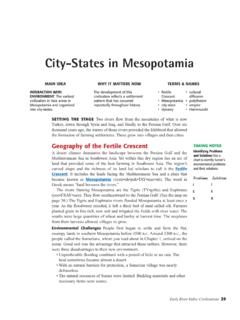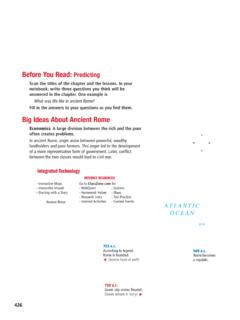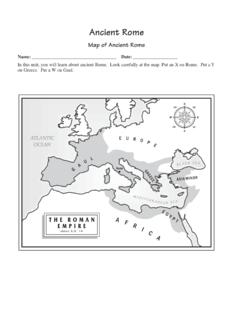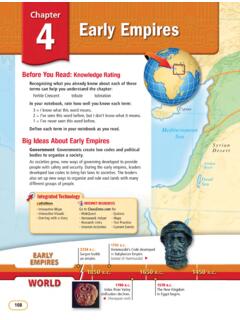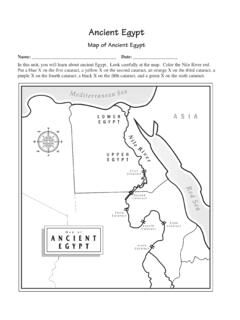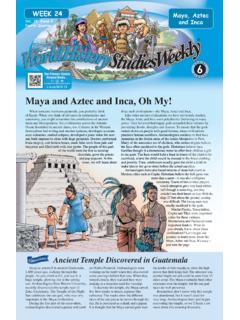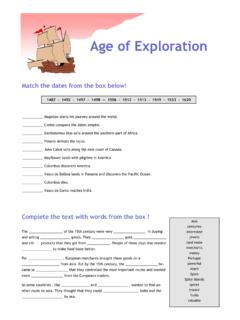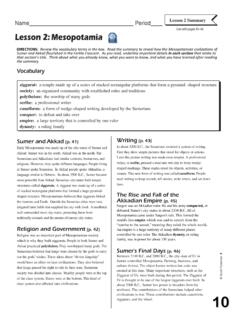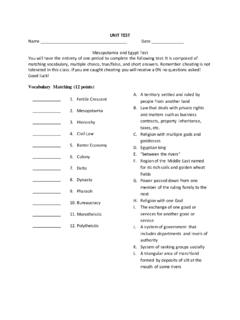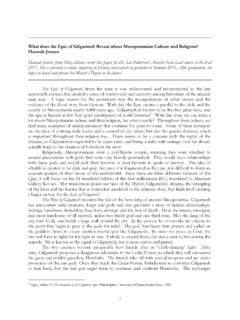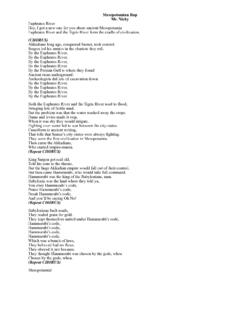Transcription of Chapter 3 Ancient Mesopotamia
1 20 E30 EAFRICAB efore You Read: Previewing Key ConceptsThe Big Idea below is a general historical idea. Rewrite this idea as three questions that can be answered as you read this Chapter . One example is:How did the geography of Ancient Mesopotamia help agriculture develop?Look for the answers to your questions as you Ideas About Ancient MesopotamiaGeography Civilizations arise in geographic locations that help the development of agriculture or trade or is a region that has two great rivers. They provided Ancient people with water for drinking and for crops. When the rivers flooded, they deposited fresh soil on the land, making it good for farming. In addition, it was easy to move trade goods by boat down the Technology Interactive Maps Interactive Visuals Starting with a StoryAncient MesopotamiaINTERNET RESOURCES WebQuest Homework Helper Research Links Internet Activities Quizzes Maps Test Practice Current EventsGo to forChapter3 Ancient MesopotamiaAncient Mesopotamia5000 by the Euphrates River begin to irrigate crops.
2 (jug, about 3000 ) 4000 dry period begins in Africa, causing the Sahara to spread. (the Sahara today)78 Mesopotamia , E30 N40 NMESOPOTAMIAM editerraneanSeaCaspianSeaRed SeaPersian GulfSUMERUrEriduUmmaLagashNippurKishASIA F ertile soil deposited by riversSumerian cultural areaModern coastlineNSEW0075150 kilometers75150 miles2400 Urukagina of Lagash reforms Narmer unifies first system of writing is in use. (tablet, about 2100 )3500 villages grow into 2500 in the Indus Valley build cities. (city ruins today)79 Background:The first people in Southwest Asia(sometimes referred to as the Middle East) were huntersand gatherers. In some places, they found animals andplants that people began to raise themselves. Someplants that people learned to grow were wild grains. Soas people learned how to plant crops for themselves, theybegan to settle in change happened over time more than 8,000 yearsago.
3 The new way of life was not always easy. Imagineyou are there as your village fights for its people learned to grow wheat for food. 80ou are a farmer in Southwest Asia. The oldest members of yourfamily decided several years ago to settle in a new village neara river. They knew the river had something special about it thatwould make this place suitable for year the river floods and puts a fresh layer of rich, dark mud onthe fields. This mud provides moisture to the soil and somehow seems tohelp plants grow. You depend on the flood to be able to year the flood never happened because there wasn t enough no moisture, the soil was hard when you were ready to plant. Yoursharpened digging stick barely penetrated the soil enough for you to putthe seeds in the the weather is hot and dry, and the tiny plants are struggling tosurvive.
4 Every day the scorching sun beats down on them. Their leaveswilt. Large cracks are appearing in the ground, and crops are brutal heat makes it difficult to work. Yet every day you must walkto the river with animal-skin bags to get water for the plants. You repeatthe trip hour after hour, until your legs feel like they won t support youany longer. Your back aches from carrying water and from bending overyour crops. The plants need every drop of moisture they can get. But theheat of the sun seems to evaporate the water as soon as it hits the times like this, farming seems like fighting a losing battle. If yourcrops die, your family won t have enough food. Trudging back and forth tothe river, you pray to the gods for help. Sick with worry, you wonder howto avoid this situation in the can you invent to make farming easier?
5 Starting with a Story1. READING: SettingSetting is the place and time of astory. How did setting influence the problem in this story?2. WRITING: ExplanationWrite a description of yourinvention. Explain how it works step by step. Conclude bysummarizing how the invention will change RamThis figurine showsa ram caught in a thicket. Itis made of gold, shell, and ablue stone called IDEASG eographyThe land between the Tigrisand Euphrates rivers was a good regionfor environment of Mesopotamiapresented several challenges to the people wholived changed theirenvironment to improve NOTESR eading Skill:SummarizingTo summarize is to restate a passage in fewerwords. After you read Lesson 1, write a sentence ortwo summarizing each of the three main a chart like this one to record your of MesopotamiaThe rivers of Mesopotamia were important because.
6 Mesopotamians watered their crops by ..Because of a lack of resources, ..Skillbuilder Handbook, page R382 Chapter 3currenta flowing partof a river or stream(page 83)Experienced travelers knewhow currents affected boatson the increase in sizeor volume (page 84)The farmers knew that theriver wouldswell, pour overits low banks, and floodtheir block up(page 85)The water slowed to atrickle because the canalthrough which it flowedwasclogged with take withoutpermission (page 85)The thieves planned tosneak into the village atnight tosteal food to KnowUnderstanding the following words will help you read this lesson:Geography of MesopotamiaBuild on What You Know Think of a time when you have seen pictures of a flood on television or in newspapers. Floods cause destruction by washing away objects in theirpath.
7 Do you think a flood can also have good consequences?The Land Between Two RiversESSENTIAL QUESTION How did the land between the Tigris and Euphrates rivers support agriculture?The Tigris (TY grihs) and Euphrates (yoo FRAY teez) rivers are in Southwest Asia. They start in the mountains of what are now Turkey and Kurdistan. From there they flow through what is now Iraq southeast to the Persian Gulf. (See the map on pages 78 79.) Mesopotamia The region where these two rivers flow is called MesopotamiaMesopotamia (MEHS uh puh TAY mee uh). The name means land between the rivers. This land was mostly flat with small, scrubby rivers provided water and means of travel. In Ancient times, it was easier to travel by boat than over land. Boats can carry heavy loads. River currents helped move boats that were traveling down river.
8 Also, few roads & NAMESM esopotamiafloodplainsiltsemiariddroughts urplusConnect to TodayEuphrates River Even today, people of Mesopotamia farm the land next to the Euphrates River. The flat land by a river is a floodplain. 83 The prefix semi-means half. The wordaridmeans d r y. A semiaridregion has some rain, but remains fairly StrategyFertile Soil Almost every year, rain and melting snow in the mountains caused the rivers to swell. As the water flowed down the mountains, it picked up soil. When the rivers reached the plains, water overflowed onto the floodplainfloodplain, the flat land bordering the banks. As the water spread over the floodplain, the soil it carried settled on the land. The fine soil deposited by rivers is called silt was fertile, which means it was good for growing Semiarid Climate Usually, less than 10 inches of rain fell in southern Mesopotamia a year.
9 Summers were hot. This type of climate is called semiaridsemiarid. Although the region was dry, Ancient people could still grow crops because of the rivers and the fertile soil. Farming villages were widespread across southern Mesopotamia by 4000 made Mesopotamia a good region for farming?Controlling Water by IrrigationESSENTIAL QUESTION How did the climate affect farmers?Being a farmer is difficult. Crops need the right amount of water to thrive. The floods and the semiarid climate in Mesopotamia meant that farmers often had either too much water or too Irrigation The model below shows how an Ancient irrigation system controlled how much water flowed from the canals led from the river. They sloped gently downward to keep the water branch canals led away from the main feeder canals led water directly to the SKILLBUILDERINTERPRETING VISUALS Human-Environment Interaction Why do you think it was important to control how much water flowed from the river?
10 84 Chapter 3 Floods and Droughts The yearly flood was unpredictable. No one knew when the flood would occur. It might come in April or as late as June. Farmers could not predict when to plant. Also, the flood s size depended on how much snow melted in the mountains in spring and how much rain fell. If there was too much, the flood might be violent and wash everything away. If there was too little rain and melting snow, the flood would not is a period when not enough rain and snow fall. In a semiarid region, drought is a constant danger. During a drought, the river level would drop, making it hard to water crops. If crops failed, people By about 6000 , farmers built canals to carry water from the rivers to their fields. Such a system is called irrigation. Often, the silt in the water clogged the canals.
